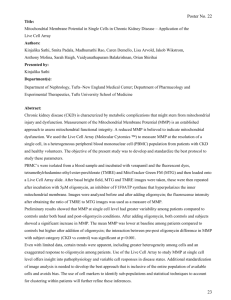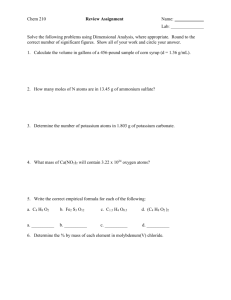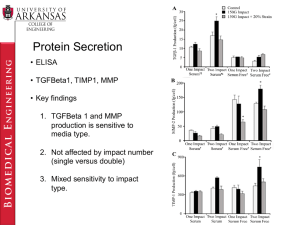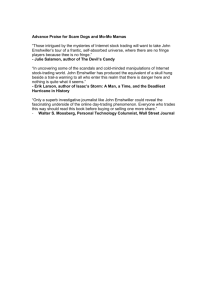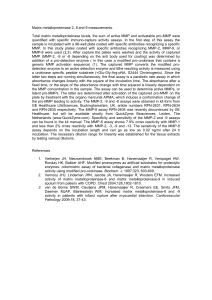Oxidative Scission of a Mo F. Albert Cotton,* Carlos A. Murillo,*
advertisement
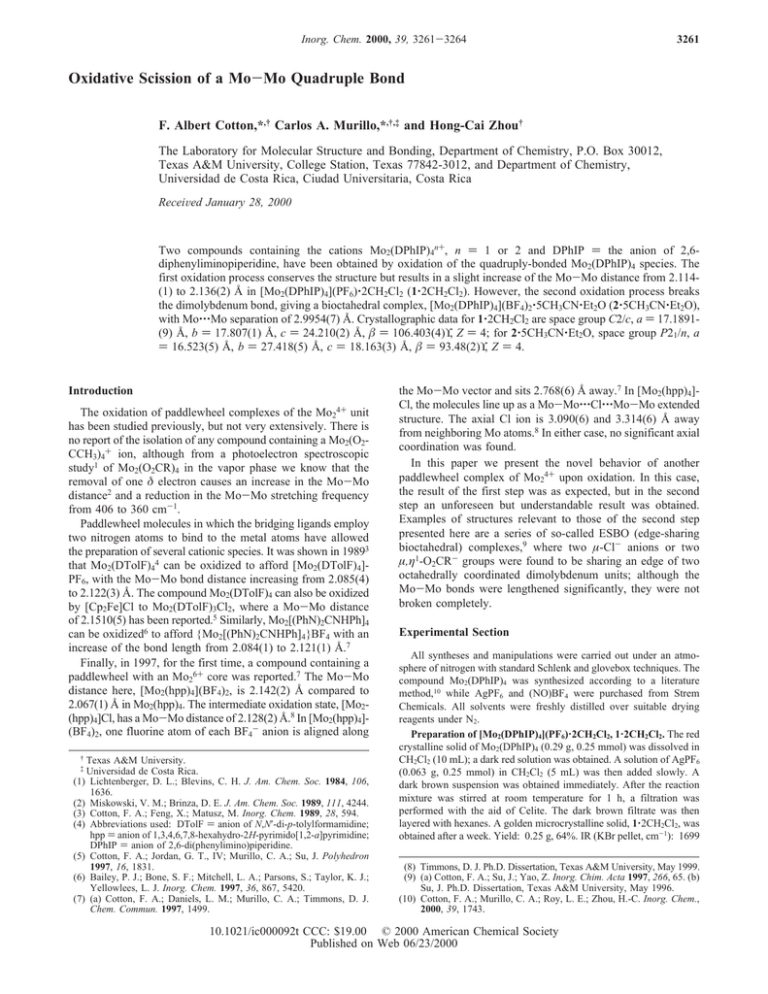
Inorg. Chem. 2000, 39, 3261-3264
3261
Oxidative Scission of a Mo-Mo Quadruple Bond
F. Albert Cotton,*,† Carlos A. Murillo,*,†,‡ and Hong-Cai Zhou†
The Laboratory for Molecular Structure and Bonding, Department of Chemistry, P.O. Box 30012,
Texas A&M University, College Station, Texas 77842-3012, and Department of Chemistry,
Universidad de Costa Rica, Ciudad Universitaria, Costa Rica
ReceiVed January 28, 2000
Two compounds containing the cations Mo2(DPhIP)4n+, n ) 1 or 2 and DPhIP ) the anion of 2,6diphenyliminopiperidine, have been obtained by oxidation of the quadruply-bonded Mo2(DPhIP)4 species. The
first oxidation process conserves the structure but results in a slight increase of the Mo-Mo distance from 2.114(1) to 2.136(2) Å in [Mo2(DPhIP)4](PF6)‚2CH2Cl2 (1‚2CH2Cl2). However, the second oxidation process breaks
the dimolybdenum bond, giving a bioctahedral complex, [Mo2(DPhIP)4](BF4)2‚5CH3CN‚Et2O (2‚5CH3CN‚Et2O),
with Mo‚‚‚Mo separation of 2.9954(7) Å. Crystallographic data for 1‚2CH2Cl2 are space group C2/c, a ) 17.1891(9) Å, b ) 17.807(1) Å, c ) 24.210(2) Å, β ) 106.403(4)°, Z ) 4; for 2‚5CH3CN‚Et2O, space group P21/n, a
) 16.523(5) Å, b ) 27.418(5) Å, c ) 18.163(3) Å, β ) 93.48(2)°, Z ) 4.
Introduction
The oxidation of paddlewheel complexes of the Mo24+ unit
has been studied previously, but not very extensively. There is
no report of the isolation of any compound containing a Mo2(O2CCH3)4+ ion, although from a photoelectron spectroscopic
study1 of Mo2(O2CR)4 in the vapor phase we know that the
removal of one δ electron causes an increase in the Mo-Mo
distance2 and a reduction in the Mo-Mo stretching frequency
from 406 to 360 cm-1.
Paddlewheel molecules in which the bridging ligands employ
two nitrogen atoms to bind to the metal atoms have allowed
the preparation of several cationic species. It was shown in 19893
that Mo2(DTolF)44 can be oxidized to afford [Mo2(DTolF)4]PF6, with the Mo-Mo bond distance increasing from 2.085(4)
to 2.122(3) Å. The compound Mo2(DTolF)4 can also be oxidized
by [Cp2Fe]Cl to Mo2(DTolF)3Cl2, where a Mo-Mo distance
of 2.1510(5) has been reported.5 Similarly, Mo2[(PhN)2CNHPh]4
can be oxidized6 to afford {Mo2[(PhN)2CNHPh]4}BF4 with an
increase of the bond length from 2.084(1) to 2.121(1) Å.7
Finally, in 1997, for the first time, a compound containing a
paddlewheel with an Mo26+ core was reported.7 The Mo-Mo
distance here, [Mo2(hpp)4](BF4)2, is 2.142(2) Å compared to
2.067(1) Å in Mo2(hpp)4. The intermediate oxidation state, [Mo2(hpp)4]Cl, has a Mo-Mo distance of 2.128(2) Å.8 In [Mo2(hpp)4](BF4)2, one fluorine atom of each BF4- anion is aligned along
†
Texas A&M University.
Universidad de Costa Rica.
(1) Lichtenberger, D. L.; Blevins, C. H. J. Am. Chem. Soc. 1984, 106,
1636.
(2) Miskowski, V. M.; Brinza, D. E. J. Am. Chem. Soc. 1989, 111, 4244.
(3) Cotton, F. A.; Feng, X.; Matusz, M. Inorg. Chem. 1989, 28, 594.
(4) Abbreviations used: DTolF ) anion of N,N′-di-p-tolylformamidine;
hpp ) anion of 1,3,4,6,7,8-hexahydro-2H-pyrimido[1,2-a]pyrimidine;
DPhIP ) anion of 2,6-di(phenylimino)piperidine.
(5) Cotton, F. A.; Jordan, G. T., IV; Murillo, C. A.; Su, J. Polyhedron
1997, 16, 1831.
(6) Bailey, P. J.; Bone, S. F.; Mitchell, L. A.; Parsons, S.; Taylor, K. J.;
Yellowlees, L. J. Inorg. Chem. 1997, 36, 867, 5420.
(7) (a) Cotton, F. A.; Daniels, L. M.; Murillo, C. A.; Timmons, D. J.
Chem. Commun. 1997, 1499.
‡
the Mo-Mo vector and sits 2.768(6) Å away.7 In [Mo2(hpp)4]Cl, the molecules line up as a Mo-Mo‚‚‚Cl‚‚‚Mo-Mo extended
structure. The axial Cl ion is 3.090(6) and 3.314(6) Å away
from neighboring Mo atoms.8 In either case, no significant axial
coordination was found.
In this paper we present the novel behavior of another
paddlewheel complex of Mo24+ upon oxidation. In this case,
the result of the first step was as expected, but in the second
step an unforeseen but understandable result was obtained.
Examples of structures relevant to those of the second step
presented here are a series of so-called ESBO (edge-sharing
bioctahedral) complexes,9 where two µ-Cl- anions or two
µ,η1-O2CR- groups were found to be sharing an edge of two
octahedrally coordinated dimolybdenum units; although the
Mo-Mo bonds were lengthened significantly, they were not
broken completely.
Experimental Section
All syntheses and manipulations were carried out under an atmosphere of nitrogen with standard Schlenk and glovebox techniques. The
compound Mo2(DPhIP)4 was synthesized according to a literature
method,10 while AgPF6 and (NO)BF4 were purchased from Strem
Chemicals. All solvents were freshly distilled over suitable drying
reagents under N2.
Preparation of [Mo2(DPhIP)4](PF6)‚2CH2Cl2, 1‚2CH2Cl2. The red
crystalline solid of Mo2(DPhIP)4 (0.29 g, 0.25 mmol) was dissolved in
CH2Cl2 (10 mL); a dark red solution was obtained. A solution of AgPF6
(0.063 g, 0.25 mmol) in CH2Cl2 (5 mL) was then added slowly. A
dark brown suspension was obtained immediately. After the reaction
mixture was stirred at room temperature for 1 h, a filtration was
performed with the aid of Celite. The dark brown filtrate was then
layered with hexanes. A golden microcrystalline solid, 1‚2CH2Cl2, was
obtained after a week. Yield: 0.25 g, 64%. IR (KBr pellet, cm-1): 1699
(8) Timmons, D. J. Ph.D. Dissertation, Texas A&M University, May 1999.
(9) (a) Cotton, F. A.; Su, J.; Yao, Z. Inorg. Chim. Acta 1997, 266, 65. (b)
Su, J. Ph.D. Dissertation, Texas A&M University, May 1996.
(10) Cotton, F. A.; Murillo, C. A.; Roy, L. E.; Zhou, H.-C. Inorg. Chem.,
2000, 39, 1743.
10.1021/ic000092t CCC: $19.00 © 2000 American Chemical Society
Published on Web 06/23/2000
3262 Inorganic Chemistry, Vol. 39, No. 15, 2000
Cotton et al.
Table 1. Crystal Data and Structure Refinement
chem formula
fw
space group
a, Å
b, Å
c, Å
R, deg
β, deg
γ, deg
V, Å3
Z
data collection
T, K
radiation λ, Å
F(calcd), g cm-3
µ(Mo KR), cm-1
R1a,c/R1a,d
wR2b,c/wR2b,d
1‚2CH2Cl2
2‚5CH3CN‚Et2O
C70H68N12Cl4F6PMo2
1556.01
C2/c
17.1891(9)
17.807(1)
24.210(2)
90
106.403(4)
90
7108.8(7)
4
Nonius FAST
213(2)
0.71073
1.454
9.13
0.086/0.105
0.207/0.234
C82H89N17OB2F8Mo2
1694.20
P21/n
16.523(5)
27.418(5)
18.163(3)
90
93.48(2)
90
8213(3)
4
Nonius FAST
213(2)
0.71073
1.370
3.79
0.054/0.063
0.131/0.147
R1 ) ∑(|Fo| - |Fc|)/∑|Fo|. b wR2 ) [∑[w(Fo2 - Fc2)2]/∑[w(Fo2)2]]1/2;
w ) 1/[σ2(Fo2) + (aP)2 + bP], P ) [max(Fo2 or 0) + 2(Fc2)]/3.
c
Denotes value of the residual considering only the reflections with I
> 2σ(I). d Denotes value of the residual considering all the reflections.
a
Table 2. Selected Bond Lengths (Å) and Bond Angles (deg) for 1
Mo(1)-Mo(1)#1a
Mo(1)-N(11)#1
Mo(1)-N(12)
2.136(2)
2.159(7)
2.132(7)
Mo(1)-N(31)#1
Mo(1)-N(32)
N(12)-Mo(1)-Mo(1)#1
N(32)-Mo(1)-Mo(1)#1
Mo(1)#1-Mo(1)-N(11)#1
Mo(1)#1-Mo(1)-N(31)#1
2.171(7)
2.131(6)
90.7(2)
91.2(2)
92.5(2)
92.2(2)
a Symmetry transformation used to generate equivalent atoms: #1
-x, y, -z + 1/2.
Table 3. Selected Bond Lengths (Å) and Angles (deg) for 2
Mo(1)-Mo(2)
Mo(1)-N(12)
Mo(1)-N(13)
Mo(1)-N(21)
Mo(1)-N(32)
Mo(1)-N(33)
Mo(1)-N(41)
Mo(2)-N(11)
Mo(2)-N(22)
Mo(2)-N(23)
Mo(2)-N(31)
Mo(2)-N(42)
Mo(2)-N(43)
2.9954(7)
2.158(4)
2.209(4)
2.157(4)
2.152(4)
2.212(4)
2.170(4)
2.169(4)
2.158(4)
2.207(4)
2.159(4)
2.150(4)
2.207(4)
N(32)-Mo(1)-N(21)
N(32)-Mo(1)-N(12)
N(21)-Mo(1)-N(12)
N(32)-Mo(1)-N(41)
N(21)-Mo(1)-N(41)
N(12)-Mo(1)-N(41)
N(32)-Mo(1)-N(13)
N(21)-Mo(1)-N(13)
N(12)-Mo(1)-N(13)
N(41)-Mo(1)-N(13)
N(32)-Mo(1)-N(33)
N(21)-Mo(1)-N(33)
N(12)-Mo(1)-N(33)
N(41)-Mo(1)-N(33)
N(13)-Mo(1)-N(33)
87.4(2)
142.8(2)
90.5(2)
92.3(2)
175.5(2)
87.0(2)
157.2(4)
88.9(2)
59.7(2)
93.0(2)
59.7(2)
93.4(2)
157.4(2)
90.3(2)
98.1(2)
(w), 1684 (w), 1648 (m), 1595 (w), 1558 (sh), 1529 (vs), 1451 (s),
1417 (m), 1370 (m), 1262 (w), 1224 (m), 1192 (m), 1075 (w), 1029
(w), 976 (w), 842 (vs), 800 (w), 765 (w), 716 (w), 698 (w), 558 (w),
508 (w), 420 (w). UV/vis (CH2Cl2): 391 nm (sh, ) ca. 6700 cm-1
mol-1 L), 446 (sh, 2450), 651 (490). Dark brown block-shaped crystals
suitable for crystallographic studies were grown by diffusion of hexanes
into a dilute CH2Cl2 solution of 1 at -10 °C for 2 weeks. Anal. for
1‚2CH2Cl2. Found: C, 53.29; H, 4.33; N, 10.36. Calcd: C, 54.03; H,
4.40; N, 10.80.
Preparation of Mo2(DPhIP)4(BF4)2‚5CH3CN‚Et2O, 2‚5CH3CN‚
Et2O. To a dark red solution of Mo2(DPhIP)4 (0.288 g, 0.25 mmol) in
CH2Cl2 (15 mL) was added NOBF4 (0.09 g, 0.5 mmol). A dark brown
suspension was obtained. After stirring overnight, the suspension was
mixed with hexanes, which resulted in the precipitation of a dark powder
in quantitative yield. Prismatic, dark-brown crystals of X-ray quality
were obtained from an CH3CN solution of 2 layered with diethyl ether
which was kept at -20 °C for 10 days. IR (KBr pellet, cm-1): 1636
Figure 1. The structure of the [Mo2(DPhIP)4]+ cation. Only one
orientation of the disordered part is shown. Displacement ellipsoids
are shown at the 30% probability level; hydrogen atoms are omitted
for clarity.
(w), 1617 (w), 1596 (w), 1577 (w), 1558 (m), 1529 (vs), 1509 (m),
1490 (m), 1473 (m), 1451 (vs), 1415 (s), 1372 (s), 1330 (w), 1262
(m), 1226 (s), 1193 (s), 1156 (w), 1072 (vs), 1050 (vs), 976 (w), 937
(w), 916 (w), 865 (m), 800 (s), 762 (m), 717 (s), 696 (s), 678 (w), 634
(w), 607 (w), 508 (m), 472 (w), 458 (w), 419 (m). UV/vis (CH2Cl2):
428 nm (sh, ) ca. 3360 cm-1 mol-1 L), 555 (310), 650 (508), 772
(50). Mass spectrometry (FAB+, NBA as matrix, m/z): 1240, [Mo2(DPhIP)4]+; 976, [Mo2(DPhIP)3]+. Anal. for 2. Found: C, 56.85; H,
4.35; N, 11.37. Calcd: C, 57.73; H, 4.56; N, 11.88.
Physical Measurements. The UV/visible spectra were measured
on a Cary 17D spectrometer at ambient temperature using a quartz
cell (800-280 nm). Infrared data were recorded on KBr pellets using
a Perkin-Elmer 16 PC FT-IR spectrometer. Cyclic voltammetry
measurements were carried out on a BAS 100 electrochemical analyzer
in 0.2 M (Bun)4NBF4 solution in CH2Cl2 with a Pt working electrode
and a Ag/AgCl reference electrode; ferrocene was oxidized at 650 mV
under the experimental conditions. NMR spectra were recorded on a
Varian VXR-300 spectrometer. Elemental analyses were performed by
Canadian Microanalytical Services Ltd.
Crystallographic Studies
All data collection was carried out on a Nonius FAST area
detector diffractometer with each crystal mounted on the tip of
a glass fiber under a stream of nitrogen at -60 °C. Cell
parameters were obtained by least-squares refinement of 250
reflections ranging in 2θ from 18.1° to 41.6°. Laue groups and
centering conditions were confirmed by axial images. Data were
collected using 0.2° intervals in φ over the range 0° e φ e
220° and 0.2° intervals in ω for two different regions in the
range 0° e ω e 72°; in this way, nearly a full sphere of data
was collected. The highly redundant data sets were corrected
for Lorentz and polarization effects and for absorption.
The positions of the metal atoms and some of the atoms of
the first coordination sphere were located from direct-methods
E-maps; other non-hydrogen atoms were found in alternating
difference Fourier syntheses and least-squares refinement cycles
and, during the final cycles, refined anisotropically. Hydrogen
atoms were placed in calculated positions.
In compound 1‚2CH2Cl2, all the phenyl rings and piperidyl
rings were found to be disordered. They were modeled as having
two or three orientations; the occupancy of each orientation was
optimized with SHELXL. In compound 2‚5CH3CN‚Et2O, the
interstitial solvent molecules were also disordered; they were
modeled as a superposition of two orientations with approximately half occupancy for each orientation.
Crystallographic data for 1‚2CH2Cl2 and 2‚5CH3CN‚Et2O are
given in Table 1; selected bond distances and angles for 1‚2CH2Cl2 and 2‚5CH3CN‚Et2O are listed in Tables 2 and 3, respec-
Oxidative Scission of a Mo-Mo Quadruple Bond
Inorganic Chemistry, Vol. 39, No. 15, 2000 3263
Figure 2. The [Mo2(DPhIP)4]2+ cation. Displacement ellipsoids are drawn at the 50% probability level; hydrogen atoms are omitted for clarity.
Figure 3. Cyclic voltammograms of (from top to bottom) Mo2(DPhIP)4, [Mo2(DPhIP)4](PF6), 1, and [Mo2(DPhIP)4](BF4)2, 2.
tively. The structures of the cations of compounds 1 and 2 are
given in Figures 1 and 2, respectively.
Results and Discussion
As shown by its cyclic voltammogram illustrated in Figure
3a, Mo2(DPhIP)4, DPhIP ) the anion of 2,6-diphenyliminopiperidine, shows a reversible and a quasi-reversible oxidation at
E1/2 values of -338 and 820 mV, respectively, suggesting that
the oxidation states Mo25+ and Mo26+ are accessible. Since the
formal potential of Ag+/Ag in CH2Cl2 is 1300 mV11 (vs Ag/
AgCl), which is higher than the second oxidation potential
shown in Figure 3a, the CH2Cl2 solution of AgPF6 needs to be
added slowly in order to oxidize the Mo24+ complex selectively
to a Mo25+ species. In CH2Cl2 solution, Mo2(DPhIP)4 reacts
with NOBF4 (formal potential of [NO]+/[NO] in CH2Cl2 is 1650
mV11 vs Ag/AgCl) giving a clean reaction and thus an
essentially quantitative yield of Mo2(DPhIP)4(BF4)2. The cyclic
voltammogram of compound 1 (Figure 3b) shows two quasireversible oxidation peaks, implying that both Mo26+ and Mo27+
oxidation states are electrochemically accessible, and one complicated irreversible reduction process, implying a possible bondbreaking process. The cyclic voltammogram of 2 (Figure 3b) is
very similar to that of the ESBO complex [PPh4][Mo2(DPhF)2(11) Connelly, N. G.; Geiger, W. E. Chem. ReV. 1996, 96, 877.
Cl4],9b suggesting there are an Mo27+ accessible species and an
irreversible reduction process.
Molecular Structure. The progression from Mo2(DPhIP)4
to Mo2(DPhIP)4+ to Mo2(DPhIP)42+ is accompanied by a
structural change at each step. In the first one, however, there
are only some small quantitative changes, with minimal
structural rearrangements as shown in Figure 1.
All that has occurred is the removal of one δ electron, and
this causes a slight increase in the Mo-Mo distance from 2.114(1) to 2.136(2) Å.This small increase results from the offsetting
effects of two factors: (1) The loss of the δ electron slightly
weakens the Mo-Mo bond by lowering the bond order. (2)
Equally important is the increase of positive charge on the metal
atoms, which causes a contraction of the entire set of 4d orbitals,
thus diminishing the σ and π overlaps. This second factor may
also be viewed as an increase in the Coulombic repulsion
between the more positive molybdenum atoms. The increase
in positive charge on the metal atoms also results in shortening
of the Mo-N bonds from an average of 2.166 to 2.148 Å.
Surprisingly, the second oxidation step results in an oxidative
scission of the Mo-Mo bond, which is quite different from
what occurs in the two-electron oxidation of Mo2(hpp)4 where
a Mo-Mo triple bond with a bond length of 2.142(2) Å was
obtained.7 The product is also different from the known ESBO
complexes where the Mo-Mo bonding was still significant (the
Mo-Mo distances ranged from 2.4 to 2.7 Å).9 The molecular
structure (Figure 2) of compound 2 shows that each DPhIP
ligand uses two of its three nitrogen donor atoms to chelate to
one Mo atom, and the third nitrogen atom to coordinate the
other Mo atom. The directions of the four DPhIP ligands
alternate around the dimolybdenum core; the idealized point
group for 2 is D2d. Each Mo atom is in a very distorted
octahedral coordination environment with an average N-Mo-N
bond angle of 59.7(2)° between the two chelating Mo-N bonds
of each ligand. The Mo‚‚‚Mo distance is 2.9954(7) Å, indicating
that there is little or probably no metal-metal bonding.
The type of bioctahedral structure found in 2 has also been
observed for V(II) and Cr(III) complexes recently.12 In all these
(12) Cotton, F. A.; Murillo, C. A.; Zhou, H.-C. Unpublished results.
3264 Inorganic Chemistry, Vol. 39, No. 15, 2000
Figure 4. 1H NMR spectrum (in CD2Cl2) and assignments of 2 showing
the downfield shift and broadening of some of the NMR signals. For
simplicity, only one H atom (on each C atom) of the two Ha-Hc atoms
of the piperidyl group is shown in the schematic formula insert.
complexes, each metal atom has a d3 configuration. One might
argue that ligand field stabilization energy would play a major
role favoring the bioctahedral coordination environment, but
other factors could also be important. The bioctahedral ligand
arrangement is an extreme case of axial π* coordination, where
the axial coordination is so strong that four M-N bonds have
taken over the M-M triple bond, whereas in the Mo2+-Mo2+
and Mo2+-Mo3+ situations the Mo-Mo bond retention is
Cotton et al.
energetically favored over the formation of four additional M-N
bonds; the axial π* coordination in the Cr2+-Cr2+ case13 implies
a balance between metal-metal bonding and metal-ligand
bonding.
Both 1 and 2 are expected to be paramagnetic. The 1H NMR
spectrum of 1 is too broad to be of value, but the spectrum of
2 shown in Figure 4 is surprisingly well resolved. Several of
the lines are quite broad and shifted significantly from the
positions where they would normally be expected. Nevertheless,
we can make tentative assignments (Figure 4) that are in accord
with the structure found in the crystal.
Acknowledgment. We are grateful to the National Science
Foundation for financial support.
Supporting Information Available: An X-ray crystallographic file,
in CIF format, is available free of charge via the Internet at
http://pubs.acs.org.
IC000092T
(13) Cotton, F. A.; Daniels, L. M.; Murillo, C. A.; Pascual, I.; Zhou, H.-C.
J. Am. Chem. Soc. 1999, 121, 6856.

